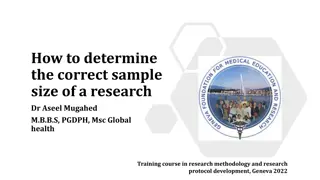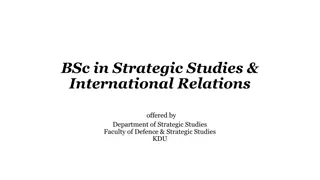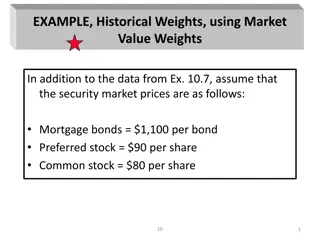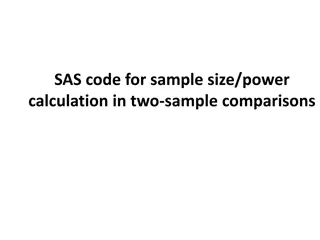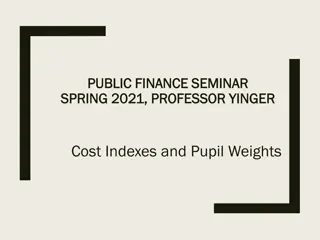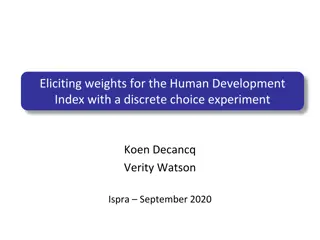Understanding Sample Design and Weights in International Education Studies
This lecture covers the design of key international surveys, response thresholds for countries, use of survey weights, replication weights, and their application using the TALIS 2013 dataset. It also explains the target population definition for PISA, exclusion rates in selected countries, stratification of school samples, and the selection process for international education studies.
Download Presentation

Please find below an Image/Link to download the presentation.
The content on the website is provided AS IS for your information and personal use only. It may not be sold, licensed, or shared on other websites without obtaining consent from the author. Download presentation by click this link. If you encounter any issues during the download, it is possible that the publisher has removed the file from their server.
E N D
Presentation Transcript
Sample design and weights Lecture 2
Aims 1. To understand the similarities and differences in the design of the key international surveys 2. To understand the response thresholds a country must meet for inclusion in the international reports. 3. To understand the design, purpose and appropriate use of the international assessment survey weights. 4. Introduce students to the use of replication weights as a method for appropriately handling complex survey designs. 5. Gain experience of the application of such weights using the TALIS 2013 dataset.
How are the large scale international studies designed?
Step 1: Define the target population PISA international target population Children between 15 years 3 months and 16 years 2 months at the start of the assessment period (typically April) Enrolled in an educational institution (home school or not-in-school excluded) National exclusions In PISA, a maximum of 5 percent of the international target population Can either be whole school exclusions (e.g. geographical accessibility) Or within school exclusion (e.g. severe disability) This informs the sampling frame for the final selected sample
Exclusion rates for selected PISA countries School exclusion % 0.7 1.2 2.7 2.0 1.4 2.2 1.4 1.4 Student exclusion % 5.7 5.0 2.9 2.1 1.0 0.0 0.2 0.1 Total exclusion % 6.4 6.2 5.6 4.1 2.4 2.2 1.6 1.5 Canada Norway United Kingdom Australia Russia Japan Germany Shanghai-China The UK has excluded more pupils from its target population than Shanghai .. Chile 1.1 0.2 1.3
Step 2: Stratify the sample of schools School sampling frame = A list of schools This frame is then stratified (ordered) by selected variables: - Schools first divided into separate groups based upon e.g. location / school type (explicit stratification) - Schools then ordered within these explicit strata by some other variable e.g. school performance (implicit stratification) Why do this? - Improves efficiency of sample design (smaller standard errors) - Ensures adequate representation of specific groups - Different sample designs (e.g. unequal allocation) can be used across explicit strata
Step 3: Selection of schools All international education studies typically use a two-stage design: - Stage 1 = Schools randomly selected from frame with PPS - Stage 2 = Pupils / teachers / classes randomly chosen from within each school Implication = Clustered sample design. Will inflate standard errors relative to a SRS. Random selection of schools conducted by the international consortium (not countries themselves). Ensures quality of the sample. - Difficult to pick a dodgy / unrepresentative sample Minimum number of schools per country (PISA = 150). - Implication Some small countries (e.g. Iceland) PISA essentially a school-level census.
Step 4: Selection of respondents Once schools chosen, respondents must be selected. Important differences between the various international studies: - PISA = Randomly select 35 15 year olds within each school (SRS within school) -TIMSS / PIRLS = Randomly selected one class within each school - TALIS = Randomly select at least 20 teachers within each school - PIAAC = Randomly select one adult from each sampled household Countries usually perform the within school sampling themselves, using the international consortiums KeyQuest software. Minimum pupil sample size required. (PISA = 4,500 children).
Non-response Problems caused by non-response - Bias in population estimates - Reduces statistical power (larger standard errors) To limit impact, international surveys have minimum response rate criteria PISA = 85% of initially selected schools. 80% of pupils within schools. TALIS = 75% of initially selected schools. 75% of teachers within schools. TIMSS = 85% school, 95% classroom and 85% pupil response. Logic Two factors influence non-response bias: a. Amount of missing data b. Selectivity of missing data If (a) is small (as countries are forced to meet the above criteria) then bias will be limited.
.but these ideal criteria sometimes not met Source: TALIS 2013 Singapore Romania Czech Republic Cyprus Croatia School response rate required = 75%. Israel Brazil Spain Mexico Iceland Bulgaria Estonia Sweden Portugal Finland Abu Dhabi Chile Japan Slovak Republic Poland Serbia France Latvia Alberta Italy Malaysia Korea Flanders Australia England 8 out of 34 countries did not meet this criteria Norway Netherlands Denmark United States 0 10 20 30 40 50 60 70 80 90 100
Replacement schools If school response falls below threshold then replacement schools are included in the calculation of the response rates. The non-responding school is replaced with the school that immediately follows it within the sampling frame (which has been explicitly and implicitly stratified). Essentially means non-responding school replaced with one that is similar .. with similar defined using the stratification variables Implication Use of replacement schools to reduce non-response bias only as good as the variables used when stratifying the sample. PISA Two replacement schools chosen for each initially sample school
Example of how sampling frame and selected schools looks . School ID Sample 1 Main sample 2 Not selected 3 Replacement 2 4 Not selected 5 Replacement 1 6 Main sample 7 Not selected 8 Main sample
Response criteria in PISA (including replacement schools) Rules when including replacement schools: 65% of initially sampled schools must take part (rather than 85%). Replacement schools can then be included. But the after replacement response rate becomes higher. Example 65% of initially sampled schools recruited, then after replacement response required = 95%. 80% of initially sampled schools recruited, then after replacement response required 87%. Country may still be included in international report even if they do not meet this revised criteria Intermediate zone = Country has to provide analysis of non-response to be judged by PISA referee (criteria unknown). Example = USA and England / Wales / NI in PISA 2009.
What do countries in the intermediate zone provide? Example: US in 2009 Compared participating and non-participating schools in observable characteristics Only those available on the sampling frame: - School type; region; school size; ethnic composition; Free School Meals (FSM) Bias based upon chi-square / t-test of difference between participants / non-participants Found difference based upon FSM but still included in the international report Limitations of the bias analysis provided Considers bias at school level only (not pupil level) Small school level sample size (not enough power to detect important differences) Very few characteristics considered
TALIS 2013 after replacement schools included Source: TALIS 2013 Singapore Romania Czech Republic Cyprus Croatia School response rate required = 75%. Israel Brazil Spain Mexico Iceland Bulgaria Estonia Sweden Portugal Finland Abu Dhabi Chile Japan Slovak Republic Poland Serbia France Latvia Alberta Italy Malaysia Korea Only the USA did not meet this criteria (and hence excluded) Flanders Australia England Norway Netherlands Denmark United States 0 10 20 30 40 50 60 70 80 90 100
Implications of missing response target Kicked out of the international report (PISA/TALIS) - England/Wales/NI in PISA 2003 - Netherlands TALIS 2008 - United States TALIS 2013 Figures reported at bottom of table instead(TIMSS/PIRLS) - England in TIMSS 8th grade 2003 Exclusion from PISA 2003 national report described by Simon Briscoe, Economics Editor at The Financial Times, as among the Top 20 recent threats to public confidence in official statistics in the UK. Being excluded still causing problems in UK politicians almost a decade later
Response rates in England/Wales/NI over time 90 Since being kicked out of PISA 2003, response rates in England/Wales/NI have improved 80 .and not only in PISA. 70 However, this then has important implications for comparisons in test scores over time 60 50 40 1999 2001 2003 2005 2007 2009 2011 PISA After TIMSS After
Why are weights needed? Complex design of the survey - Over / under sampling of certain school / pupil types - (e.g. over-sampling of indigenous children in Australia) Non-response - Despite use of replacement schools, certain types of schools may be under- represented. - Certain types of pupils may be under-represented. The PISA survey weights thus serve two purposes: - Scale estimates from the sample to the national population - Attempt to adjust for non-random non-response
How are the final student weights defined? A (simplified) formula for the final student weights in PISA is given as follows: ???= ?1? ?2?? ?1? ?2?? ?1? ?2?? Where ?1? = The school base weight (chance of school i being selected into sample) ?2?? = The within school base weight (chance of respondent j being selected within i) ?1? = Adjustment for school non-response ?2?? = Adjustment for respondent non-response ?1? = School base weight trimming factor ?2?? = Final student weight trimming factor i = School i j = Respondent j
The base (design) weights (W) School base weight (???) Reflects the probability of a school being included in the sample. = 1 / probability of inclusion of school i (within explicit stratum) Within school base weight (????) Reflects the probability of a respondent (e.g. pupil) being included in the sample, given that their school has been included in the sample. = 1 / probability of student j being selected within school I = number of 15 year olds in school i / sample size within school i Above holds for PISA/TALIS as SRS is taken within selected schools .. .different for PIRLS / TIMSS as SRS not taken within schools (classes selected) In the absence of non-response, the product of these two weights is all you need to obtain unbiased estimates of student population characteristics.
Non-response adjustments (f) Weights adjusted to try to account for non-response. Adjustment only effective if these variables both (a) predict non-response and (b) are associated with the outcome of interest (e.g. achievement). School non-response adjustment (???) Adjust for non-response not already accounted for via use of replacement schools. Usually based upon stratification variables. Groups of similar schools formed (using stratification variables). Adjustment then ensures that participating schools are representative of each group. the importance of these adjustments varies considerably across countries. (Rust 2013:137) Respondent non-response adjustment (????) Few pupil level factors can be taken into account (gender and school grade only). In most cases, reduces to the ratio of the number of students who should have been assessed to the number who were assessed. (OECD 2014:137) Implication probably not that effective.
Trimming of the weights (t) Motivation Prevents a small number of schools / pupils having undue influence upon estimates due to being assigned a very large weight. Very large weights for small number of pupils risks large standard errors and inappropriate representations of national estimates. Strengths and limitations of trimming -ive = Can introduce small bias into estimates +ive = Greatly reduces standard errors School trimming: Only applied where schools were much larger than anticipated from the sampling frame (3 times bigger) Student weight trimming: Final student weight trimmed to four times the median weight within each explicit stratum. PISA (2012): For most schools / pupils trimming factor = 1.0. Very little trimming needed.
Implication.. The student response weights should be applied throughout your analysis .. Only by applying these weights will you obtain valid population estimates that - Account for differences in probability of selection - Adjust (to a limited extent) for non-response Stata Use of the survey svy . Specifying [pweight = <final respondent weight>] when conducting your analysis. Remember Also need to apply these weights when manipulating the data in certain ways .. . E.g. creating quartiles of a continuous variable when using xtile command.
Does applying the weight actually make a difference?? Example PISA 2009 in UK With weights % of total Without weights Sample size total Population size % of Mean Mean Applying weights England drives UK figures Wales little influence England 570,080 83 493.0 4,081 34 495.0 Scotland 54,884 8 499.0 2,631 22 499.0 Northern Ireland 23,151 3 492.2 2,197 18 494.0 Without weights Wales (low performing outlier) has more influence on the UK figure .. disproportionate to what it should do (relative to its population size) Wales 35,264 5 472.4 3,270 27 473.0 Total (Whole UK) 683,379 100 492.4 12,179 100 489.8
Example application: how many high achieving children are there in the UK? Can also use the weights contained in PISA / TALIS etc in other interesting ways Sutton Trust asked me to estimate the absolute number of high achieving children from non-high SES backgrounds there are in the UK (and how many of these are in low achieving schools). PISA weights scale from sample up to population estimates. Can therefore use the PISA total command to answer this question (along with standard error). High achieving = PISA level 5 in either maths or reading Not high social class = Neither parent professional job Not high parental education = Neither parent holds a degree School performance = school average PISA maths quintile
How many high achievers are there in the UK? High achievers N =90,460 Parents Professionals Missing data Parents not Professionals N = 60,300 N = 360 N = 29,800 Parents with degree Parents without degree Missing data N =8,350 N = 20,870 N = 570 School top quintile School Q2 School Q3 School Q4 School bottom quintile N = 5,000 N = 3,260 N = 8,300 N =2,525 N = 1,790
Motivation Large-scale international survey have a complex survey design. Schools selected as the primary sampling unit. (I.E. Children clustered within schools) Violates assumption of independence of observations required to analyse the data as if collected under a simple random sample. Standard errors will be underestimated unless this clustering is taken into account. Stratification Also influence SE s. Need to be taken into account.
Common methods for handling complex survey designs 1. Huber-White adjustments (Taylor linearization) Adjust the standard errors to take into account clustering (and stratification) by making an appropriate adjustment to standard errors. Implemented by using Stata svy command: svyset SCHOOLID [pw = Weight] , strata(STRATUM) svy: regress PV1MATH GENDER Accounts for clustering, stratification and weighting. 2. Estimate a multi-level model Pupil / teacher (fixed) characteristics at level 1. School random effect at level 2. Standard errors account for clustering of children within schools Stratification How to also take this into account? Weights Appropriate application not straightforward
Limitation of common approaches Both methods require that a cluster variable (e.g. school ID) and a stratification variable is provided in the public use dataset. Big issue for some countries. Concerns regarding confidentiality. Some schools / pupils become potentially identifiable. Likely to be biggest issue in countries with very tight data security (e.g. Canada) or with small populations (e.g. Iceland) where essentially all schools sampled. Major +ive of replication methods: - Cluster and / or strata identifier does not have to be included - All the information needed is provided via a set of weights instead ..
The intuition behind replication methods Example: Bootstrapping Perhaps the most well-known (and widely applied) replication method Use information from the empirical distribution of the data to make inferences about the population (e.g. to calculate standard errors) NOTE: The international education datasets do not use bootstrapping, but other (similar) methods that are based upon a similar logic ..However, I am going to discuss bootstrapping in the next few slides to get across the broad intuition of the argument and how replicate weights work
What is bootstrapping? Say you have a sample of n = 5,000 observations that accurately represent the population of interest. You calculate the statistic of interest (e.g. mean) from this sample. From within your sample of 5,000 observations: - Draw another sample of 5,000 (with replacement) - Calculate statistic of interest (e.g. mean) Repeat the above process many times (m bootstrap replications ) NB: Sample with replacement so BS sample not same as the original sample .. 34
What is bootstrapping? Now have: i. the mean from our sample ii. a distribution of possible alternative means (based upon the BS re-samples). Using (ii) we could draw a histogram of how much our estimate of the mean is likely to vary across alternative samples .. .And we can also calculate the standard deviation BS Standard Error The standard deviation of the m bootstrap estimates. Provides a remarkably good approximation to analytic SE 35
The replication weights provided in PISA etc work in a very similar way .. The replicate weights contain all the information you need about the re-samples (i.e. you do not need to draw these yourself as in the BS ). The statistic of interest (?) is calculated R times (once using each replicate). The standard error of ? is then estimated based upon the difference between the R replicate estimates ?? and the point estimate calculated using the final student weight (? ). The exact formula used to produce this standard error depends upon the exact replication method used .. .and this varies across the international achievement datasets
Which replication method does each survey use? Number of replicate weights provided Survey Method PISA BRR 80 TALIS BRR 100 PIAAC JK1 (5 countries) or JK2 (20 countries) 80 TIMSS JK 75 PIRLS JK 75 Result: Each survey contains a set of R replicate weights. Implications These weights, along with the final respondent weight, are all you need to accurately estimate standard errors / p-values. It is only possible to replicate the official OECD / IEA figures by using these weights.
A brief note about degrees of freedom and critical values. Population size = 43826.927 Replications = 100 Number of degrees of freedom = Number of replicate weights 1. Design df = 99 F( 0, 99) = . Prob > F = . Impacts the critical value used in significance tests and CI s. R-squared = 0.0000 Critical t-stat is 1.9842, rather than 1.96, when testing statistical significance at the five percent level. BRR * Valued_Soc~y Coef. Std. Err. t P>|t| [95% Conf. Interval] _cons .1049337 .0056648 18.52 0.000 .0936936 .1161738 Makes only a small difference only important when right on the margins .
How do you use these replicate weights? See computer workshop providing examples using TALIS 2013 data!
Does this all matter? A comparison of results Use TALIS 2013 dataset Estimate the average age of teachers in a selection of participating countries Produce estimates the following four ways: 1. No adjustment for complex survey design 2. Application of survey weights only 3. Application of survey weights + Huber-White adjustment to standard errors 4. Application of survey weights + BRR replicate weights Compare the four sets of results to the figures given in the official OECD TALIS 2013 report. Is there much difference between each of the above? (In this particular basic analysis)
Does this all matter? A comparison of results Survey weights + clustered SE Survey weights only Survey + BRR weights OECD official figures Little impact upon the mean age estimate Country SRS Mean age Mean age Mean age Mean age Mean age SE SE SE SE SE but the standard error changes quite a bit (even between linearization and BRR estimates) Singapore 36.039 0.182 36.013 0.186 36.013 0.215 36.013 0.177 36.013 0.177 England 39.011 0.208 39.180 0.235 39.180 0.281 39.180 0.255 39.180 0.255 Chile 41.225 0.292 41.336 0.310 41.336 0.449 41.336 0.453 41.336 0.453 Norway 44.070 0.213 44.244 0.315 44.244 0.430 44.244 0.439 44.244 0.439 Spain 45.515 0.148 45.566 0.166 45.566 0.268 45.566 0.236 45.566 0.236
Conclusions All of the international datasets use a complex survey design. Strict criteria for response rates though there is also some flexibility ..But OECD will chuck your country out if response rate really is too low Survey weights incorporate complex design, non-response adjustment and (very limited) trimming. Only by applying these weights will your point estimates be correct (i.e. consistent estimates of population values) Replication methods are used to estimate standard errors (and associated significance tests and confidence intervals) . .Only by using these weights will you be able to replicate the OECD / IEA figures




